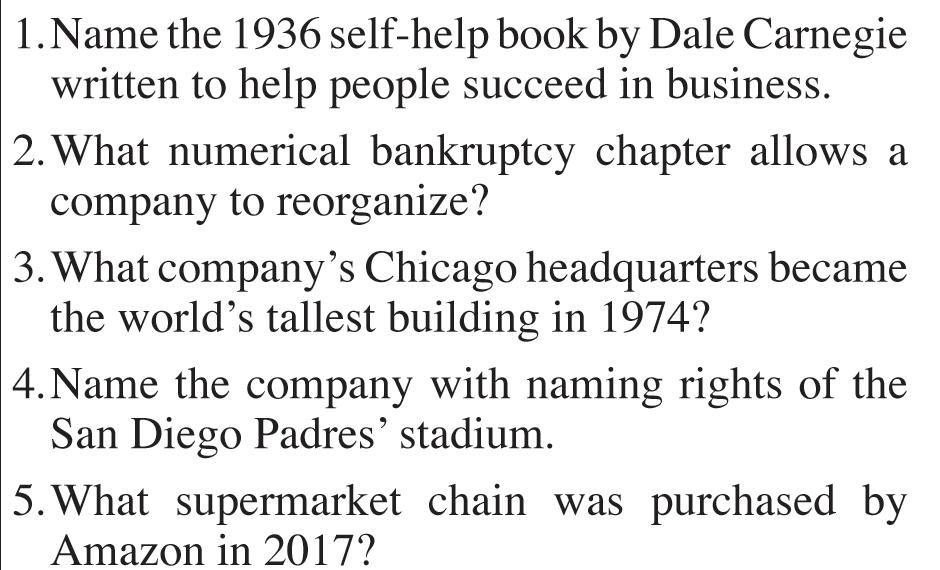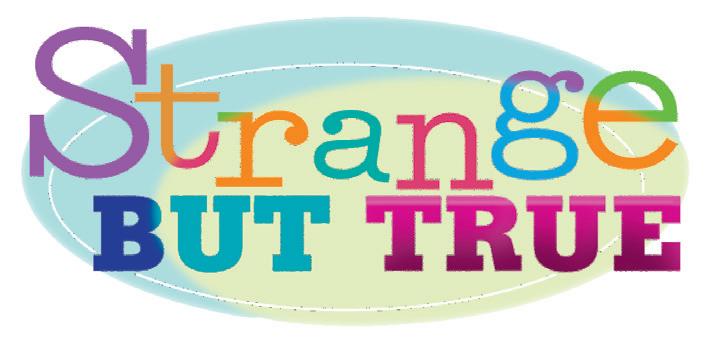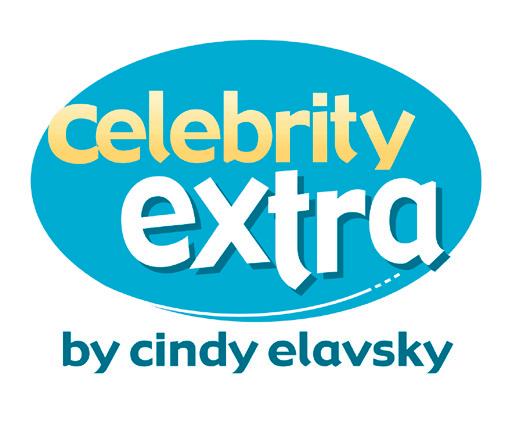



























by Kathy Wolfe
Letʼs get down to business! Companies with fewer than 100 employees are generally considered to be in the small business class, and those with a payroll between 100 and 1,500 are ranked in the mediumsize category. While the majority of businesses are ranked somewhere within these two categories, Tidbits focuses this week on the big business giants, the heavy-hitting Goliaths that collectively impact our global economy.

• Walmart is the world’s largest private employer, with about 2.1 million employees, with 76.2% of those in the United States. They are also the largest in terms of revenue with sales, with $681 billion in revenue last year. The company operates upwards of 10,700 stores worldwide, with about 5,200 of those in the U.S. More than 255 million shoppers visit Walmart in an average week around the world. Ninety percent of the U.S. population lives within 10 miles of a Walmart.




• Amazon with its 1,556,000 employees is the world’s second-largest employer. The company

















(Answers on page 16)



• Originally called “wrist wrestling,” the sport of arm wrestling has its beginnings in the 1950s in Petaluma, California. Although folks had participated in the sport for years, it was a photo journalist named Bill Soberanes who devised the idea of organized tournaments.
• Bill was a regular patron of Petaluma’s Gilardi’s Corner Bar, where he gathered inspiration for his weekly newspaper column. Here he encountered Jack Homel, a trainer for the Detroit Tigers baseball team, who bragged he had never lost a wristwrestling match to a single one of his hundreds of opponents. A local rancher, Oliver Kullberg, purported to be the area’s strongest man, made the same claim.
• Soberanes organized a fundraising match for the March of Dimes, pitting Homel and Kullberg against each other, with the event scheduled for January 27, 1955.


1. ANIMAL KINGDOM: What is a female goat called?
2. TELEVISION: What is the name of the town in “Gilmore Girls”?
3. GEOGRAPHY: How many states does the Appalachian Trail cross?
4. MOVIES: Which actress voices the character Jessie in “Toy Story 2”?
5. U.S. PRESIDENTS: What is believed to have caused President Zachary Taylor’s death?
6. ANATOMY: What is the most abundant protein in the human body?
7. GEOMETRY: How many sides does a hexagon have?
8. LITERATURE: Serial killer Hannibal Lecter first appears in which novel?
9. ASTRONOMY: What are planets outside our solar system called?
10. MUSIC: Who was the first women inducted into the Rock & Roll Hall of Fame?
• The match’s result was a draw, but it started a popular craze in Petaluma, leading Soberanes, Homel, and Kullberg to create an annual tournament. This grew into the world’s first professional Wrist Wrestling Championship in 1962. It was a sad day in 1967 when Gilardi’s Corner Bar was torn down to make room for a an adjacent bank’s parking lot.
• The sport dates back to ancient Egypt, where hieroglyphs depicting matches from 2038 B.C. were discovered. It was common for Native American tribes to use arm wrestling to settle arguments and demonstrate strength.
• During the mid-20th century, arm wrestling was a common activity in Boy Scouts troops. From 1969 to 1984 arm wrestling tournaments were broadcast on “ABC’s Wide World of Sports,” viewed by an estimated 300 million followers during that period.
• Popularity of the sport soared in 1968 when cartoonist Charles Schulz featured it in his “Peanuts” comic strip. Snoopy traveled to Petaluma to compete in the arm wrestling championship, but was disqualified due to his lack of thumbs.
• Standardized rules and official competitions came along with the establishment of the World Arm Wrestling Federation in 1977, which now has 80 participating countries.
• Today’s competitive matches are held on a specialized table with elbow pads and hand grips. Competitors lock hands and attempt to force the opponent’s arm down to the horizontal surface. Elbows must be kept on the pads. If the elbow is lifted or the opposite hand is removed from the hand grip, a foul is called.
• A variety of techniques are involved in the sport. The “top roll” aims to roll the opponent’s wrist back using a downward rotation of the palm, wrist, and forearm. The “hook” uses the bicep and shoulder muscles to pull the opponent’s arm toward the body, reducing the opponent’s leverage. The “press” technique involves pushing the opponent’s arm down by getting body weight behind the push.
• Training for arm wrestling includes bicep curls, hammer curls, wrist curls, and pull-ups. Wrestlers incorporate bench pressing, dumbbells and barbells, and resistance bands into their workout. Cable systems with specialized handles imitate the angles and tensions of actual arm wrestling.
• While arm wrestling builds strength in the upper body – muscles, shoulders, and chest – along with grip strength, there are several injuries associated with the sport. No other sporting activity puts more stress on the arm’s humerus bone, resulting in frequent fractures. Shoulder dislocation, soft tissue damage, muscle strains, ligament tears, nerve injuries, and tendonitis are all risks that the arm wrestler takes.




Week of July 13, 2025
Big Business: (from page one)
started out as an online bookstore in Jeff Bezos’ parents’ garage in Bellevue, Washington. Bezos’ parents had withdrawn $300,000 from their retirement accounts to help their son get started.
• On April 3, 1995, Bezos sold the first book ordered on the new site, a science book called Fluid Concepts and Creative Analogies, authored by Doug Hofstadte. No profits were reported until the final quarter of 2001, and it wasn’t until 2004 that Amazon recorded its first annual net profit. Twenty years later, Amazon’s annual revenue for 2024 was nearly $638 billion.
• Apple is the world’s most valuable brand, followed by Microsoft, Google, Amazon, Walmart, Samsung, TikTok, and Facebook. Brand value is not the same as sales. Although Walmart is #1 in terms of revenue, the chain is #5 on the list of brand value. Brand value is based on profits generated, the brand’s strength, equity, and investment.
• In 1937, Vernon Rudolph opened a doughnut shop in Winston-Salem, North Carolina, using a recipe his uncle had purchased from a New Orleans chef in 1933. The shop was called Krispy-Kreme, and Rudolph began selling franchises in the 1940s. Today, the company operates about 1,400 stores in more than 30 countries around the world, including Australia, Egypt, Iceland, Thailand, Brazil, and Nigeria. The Paris, France store makes about 45,000 doughnuts a day. Net revenue for Krispy-Kreme in 2024 was $1.7 billion.
• Two Stanford University engineering graduates, Jerry Yang and David Filo, launched Yahoo! in January 1994 under the name “Jerry and David’s Guide to the World Wide Web” as a directory of other websites. Three months later, they changed the name to Yahoo!, an acronym for “Yet Another Hierarchical Officious Oracle.” Yahoo! was one of the original internet giants, and the

first to offer news, sports, and financial info. In 1998, they added e-mail, shopping, classifieds, personals, games, travel, weather, people search, and maps.
• At their peak, Yahoo! was the world’s largest internet company, worth $125 billion. The company turned down purchase offers from Microsoft, although their popularity was waning. Massive data breaches in 2013 and 2014 affected more than a billion accounts, as the company’s value continued to decline. In June 2017, Yahoo! was sold to Verizon for $4.83 billion.
• The premium television network Home Box Office was launched in November of 1972, the first service to directly transmit signals via communications satellites. The first HBO telecast was an NHL game between the New York Rangers and the Vancouver Canucks from Madison Square Garden. There was a $6 fee to receive the programming launch.
largest producers of contact lenses, along with their Ray-Ban sunglasses line, the best-selling sunglasses in the world, and employs more than 13,500 people.
• The world of commerce isn’t all about big business. Small businesses comprise 90% of all companies around the world, providing 50% of jobs globally. About 50% of these start at the owner’s home, with 44% of small business owners between the ages of 39 and 54.
• Unfortunately, it’s harder for a small business to get a bank loan, and only about 50% of small businesses survive five years or longer. Just 30% make it to ten years. Sadly, during the Covid pandemic about 60% of small companies were forced to shut down.
• A family disagreement led to the founding of two of the world’s largest sportswear companies. Two brothers, Adolf and Rudolf Dassler established a shoe manufacturing company byKaraKovalchik&SandyWood
The Yum! Brands Corporation owns Pizza Hut, Taco Bell, KFC, The Habit Burger Grill, and Wing Street, operating more than 61,000 restaurants in 155 countries worldwide.
• In January 1974, HBO expanded its programming to eight hours per weekday and 12 hours on weekends. In April 1976, there were 386,000 subscribers. The service added concert specials



Measurements We Can Customize to Your Exact Measurements


In August 2013, the Amazon website experienced a glitch and was down for about about 40 minutes. Users re ceived an error message, “Oops! We're very sorry, but we're hav ing trouble doing what you just asked us to do.” Based on Amazon’s previous quarter's sales, those 40 minutes cost the company close to $5 million.


















By Lucie Winborne
* The first staplers were invented in the 18th century for King Louis XV of France, though the word “stapler” wasn’t commonly used until 1901. These early devices were cumbersome and often required force to operate, with some even needing a hammer or mallet.
* Occupational therapy techniques date to 100 B.C., when a Greek physician named Asclepiades used them to treat mental illness.
* The tradition of playing loud music at an Irish wake originated with the belief that it would ward off evil spirits. Wakes also provided the opportunity to watch over the deceased to see if they would awaken.
* The Firefox logo isn’t a fox, but a red panda.
* If your hat falls off during a tennis match, your opponent has the option to declare it a “hindrance” and redo the stroke.
* The temperature of a shooting star is around 3,000 degrees Fahrenheit.
* In 2019, a British woman married her dog. Her motive? After four failed engagements, 220 dates and a general range of unsatisfying experiences in the search for Mr. Right, she had given up on men but felt she and her dog had saved each other.
* “Crab mentality” refers to the “If I can’t have it, neither can you” line of thinking, due to the fact that when a crab in a bucket attempts to escape, its fellow crabs pull it down.
* Trypophobia is the fear of closely packed holes.
* A flute is technically any open tube that one blows into to produce sound -- even, for example, an empty Coke bottle! ***
Thought for the Day: “I don’t believe you have to be better than everybody else. I believe you have to be better than you ever thought you could be.”
-- Ken Venturi


by Mary Hunt


can use, without having to pay full price for it. If one of your early arrivals insists on offering only a low-ball price on something you're sure will easily sell, suggest they come back toward the end of the day. If the item is still unsold, take their offer. The goal is to get rid of your stuff while simultaneously recouping some of the money you spent to buy it in the first place. Research the price of similar items on eBay or Craigslist.
Whether your goal is to purge your home of stuff you no longer need, or you want to raise some cash -- or both -- you have options.

by Mary Hunt
You can sell your items on an auction website like eBay.com, list them in the classified in a local newspaper or on craigslist.org. You can unload unwanted clutter on social platforms like Nextdoor and Facebook Marketplace. But some things never change. There’s just nothing like a well-organized, killer garage sale to turn your castoffs into cold, hard cash.
Depending on where you live, you may call it a “yard sale,” “garage sale” or “tag sale,” but all of its monikers mean the same: We’re ready to negotiate because everything must go!
Give yourself more than a few weeks to get ready. Check local laws regarding signage, restrictions and a requirement, if any, to get a permit. Make sure you consider what else is happening on the weekend you have in mind. You don’t want to go up against major competing events, such as your town’s high school graduation or the opening date of the fair. You do want to time your sale to coincide with complementary events, such as arts festivals that bring lots of foot traffic to your neighborhood or seasonal “yard sale days” sanctioned by your local community.
Assume that nobody wants to buy dirty, dusty or broken items. That means everything you are selling needs to be cleaned prior to the sale. Don’t go overboard; just make sure everything in your sale is as attractive as possible.
It pays to put your stuff in order. Designate your sale area. If there are items in close proximity that are not for sale, cover or clearly mark them “not for sale.” Take the time to repair and clean your sale items, and your sale area, too. Dirt, grime, chaos and clutter will repel shoppers. A nicely ordered space will draw people who are ready, willing and able to buy.
The majority of people who pass through your sale are merely looking for something they

At the very least, put a sign at the end of your street. If you really want to attract motivated buyers, get serious about the advertising. Consider an ad in a local newspaper. Garage sale junkies routinely peruse these ads every week. Join NextDoor, where you can interact with neighbors and get the word out about your sale. You can advertise your garage sale for free on dozens of reputable websites, such as GarageSaleFinder.com Put some time and effort into this because you want your ad to stand out.
Make your layout deliberate. Group things in sections. For example, put all kitchen items together in one area, and toys and games in another. Make sure all of your clothes are hung. Rig up makeshift hanging clothes racks with two ladders or hooks from the ceiling. Do not pile clothes on a table or in boxes.
This is the checkout area where you will collect money. This is a great place to sell cookies, coffee, sticky buns and bottles of water. If you have lots of small random items like small toys, jewelry and other items that don’t go with anything else, divvy them up into small lunch bags, tape them closed and mark as “grab bags!” Add a reasonable price and place them right at the checkout. Sit back and watch them fly off the table.
While mobile payment technology like Venmo and Cash App is often expected these days, some garage sale buyers still prefer good old cash! That means you’ll need plenty of change in your cash box to break $20 and $50 bills early in the day. Visit the bank a few days before your sale and pick up at least $100 in change. While at the bank, pick up a reusable cash envelope (or repurpose an envelope from your house) to ferry cash to a secure location inside the house. Slim down the amount of cash folks can see by periodically moving some into the house. You don’t want random people eyeing the hundreds in cash you’re likely to have on hand and visible during a busy sale.
Always, for a variety of important reasons, enlist a friend or neighbor to assist you. And if you want to knock your sale out of the park, get some expert help. If you want to learn from the best, and send your profits through the roof, read “The Garage Sale How-To Guide: Everything You Need To Know To Hold A Successful Garage Sale” by Cindy Sabulis. This guide is absolutely worth its weight in gold - and it's also a great gift idea!
* * *
“Ask Mary.” This column will answer questions of general interest, but letters cannot be answered individually. Mary Hunt is the founder of EverydayCheapskate.com, a frugal living blog, and the author of the book “Debt-Proof Living.”
COPYRIGHT 2025 CREATORS.COM



In honor of Shark Awareness Day on July 14, Tidbits focuses on these amazing fish, a group consisting of more than 500 species.
• Sharks are “elasmobranches,” a fancy word that means that their skeletons are made of cartilage rather than bone. They have the thickest skin of any animal species in the world, with some sharks’ skin measuring 6 inches (15 cm) thick. The skin is like sandpaper, consisting of tiny teeth-like scales.
• Most sharks never sleep since they must be constantly moving in order to pump water through the mouth over the gills to to capture oxygen in order to survive.
• Sharks have good eyesight and amazing hearing. The back of their eyeballs have a reflective layer of tissue that enables them to see well with very little light. They also have a wide view of their surroundings because the eyes are wideset and located on the sides of the head. The sensory organs allowing them to detect sound are located inside their heads. These are quite sensitive with the ability to hear their prey nearly 3,000 feet (914 m) away. Sharks also have the largest brains of any fish.
• What sharks don’t have is vocal cords. This means they make no sound, leading to their nickname of the “silent killers.”
• A whale shark is the biggest fish in the ocean. It reaches a length of nearly 45 feet (13.8 m), although some as long as 60 feet (18 m) have been reported. The typical adult whale shark can weigh as much as 41,000 lbs. (18,000 kg). Its mouth can contain more than 300 rows of
tiny teeth.
• With that bulk, it’s no wonder that whale sharks are slow swimmers, traveling at a speed of just over 3 mph (4.8 km/hr). It’s believed that these huge sharks could have a lifespan between 100 and 150 years.
• The smallest shark in the world is the dwarf lantern shark, a variety that is just short of 7 inches (17.8 cm) in length. This miniature shark is found only in the waters off the coast of Colombia and Venezuela.
• The 1975 movie “Jaws” caused fear among many beachgoers making them afraid to get into the water at all! The killer fish in the film was a Great White shark, a fish that measures about 19 feet (5.8 m) in length and weighs around 4,400 lbs. (2,000 kg). They can swim at speeds of 16 mph (25 km/hr) and can jump 10 feet (3 m) out of the water to catch their prey.
• They are responsible for the largest number of fatal unprovoked shark attacks on humans, yet humans are not their preferred food. They’d rather eat fish, seabirds, rays, squid, seals, sea lions, dolphins, and even other sharks smaller than they are, consuming an average of 11 tons of food every year. Even with that amount, they can go three months without eating. Great white shark attacks on humans occur about 10 times a year around the world.
• A Great White shark has an estimated lifespan of 70 years or more. It takes 26 years for a male to reach maturity, and the female isn’t ready to produce offspring until she is 33 years old.
• A shark’s age can be determined by counting the pairs of translucent bands on their vertebrae. Ten ring pairs on the vertebrae means the shark is 10 years old.
• How about these unusual species? Thresher sharks slap their prey to death with their tails. Lantern sharks are bioluminescent and glow in the dark. Angel sharks snare their prey in just one-tenth of a second. Bamboo sharks can’t bend their bodies to swim and move across the ocean floor using four fins as propellers.



by Dana Jackson

Q: What ever happened to the new “Cape Fear” movie with Tom Hardy? Wasn’t it supposed to come out a couple years ago? -- D.E.
A: It was fake news. You probably saw an ad featuring a movie poster of Tom Hardy, Mark Ruffalo, and Emily Blunt starring in the remake of “Cape Fear.” It certainly looked like great casting with Hardy in the menacing role Robert De Niro played in 1991 (and Robert Mitchum played in the original 1962 version). However, as enticing as this remake looked with the amazing Hardy playing a cigar-chomping Max Cady, it never came to fruition.

There is a remake in the works but in the form of a series with an entirely different cast. Javier Bardem, who won an Oscar for his portrayal of another conscienceless killer in the 2007 film “No Country for Old Men,” is taking on the De Niro role. The 10-episode series is currently in production in Atlanta with an eventual release on Apple TV+ in 2026. It will co-star Amy Adams (“Sharp Objects”) and Patrick Wilson (“Fargo”).

1. F1: The Movie (PG-13) Brad Pitt, Damson Idris
2. How to Train Your Dragon (PG) Mason Thames, Nico Parker
3. Elio (PG) Yonas Kibreab, Zoe Saldaña
4. M3GAN 2.0 (PG-13) Allison Williams, Ivanna Sakhno
5. 28 Years Later (R) Jodie Comer, Aaron TaylorJohnson
6. Lilo & Stitch (PG) Maia Kealoha, Sydney Agudong
7. Mission: Impossible - The Final Reckoning (PG-13) Tom Cruise, Hayley Atwell
8. Materialists (R) Dakota Johnson, Chris Evans
9. Ballerina
(R) Ana de Armas, Keanu Reeves
10. Karate Kid: Legends (PG-13) Jackie Chan, Ben Wang
As for Hardy, his new Paramount+ series “MobLand” has already been renewed for season two, and he has two films in development: “Mad Max: The Wasteland” and a film about Navy SEALS called “War Party.”
Q: Why did they cancel “Grosse Pointe Garden Society”? Is there a chance it could wind up somewhere else? -- K.D.
A: According to TVLine, the dramedy about four members of a suburban garden club mixed up in mischief and murder was canceled by NBC after one season. The first clue was probably the fact that it was moved from Sunday to Friday nights after just three episodes. Despite the fact that it came from the creative mind of Jenna Bans, who’s behind hits like “Desperate Housewives” and “Scandal,” it just didn’t catch on.
Melissa Fumero (“Brooklyn Nine-Nine”), who played messy socialite Birdie in the series, calls her character “one for the books” and says she’ll “miss the incredible group of humans” involved with the show. As for the chance that “Grosse Pointe Garden Society” could be rescued by a streamer like Netflix, it’s definitely not unheard of, but the cast and crew seem to have accepted the show’s fate.
***
Q: Will “The Bear” be back for another season on Hulu after the current one? I keep reading that this might be the last one. -- D.A.
A: Hulu hasn’t yet announced if its crown jewel “The Bear” with its 21 Emmy wins will be renewed for a fifth season, but they’d be crazy not to renew it. The decision surely rests in the hands of the show’s creator, Christopher Storer, and his busy cast.

The series’ main star, Jeremy Allen White, might soon be adding an Oscar next to his Emmy if his portrayal of the Boss in the upcoming film “Springsteen: Deliver Me from Nowhere” is as impressive as expected. His “Bear” co-star Ebon Moss-Bacharach stars in “The Fantastic Four: First Steps,” which will surely make a big splash at the box office. * * *
Send me your questions at NewCelebrityExtra@gmail.com.




No need to make cornbread and chili -- in a cast iron skillet, with this dinner recipe, you can make both at once, pie-style.
1/4 cup vegetable oil
1 pound ground beef chuck
1 large onion, finely chopped
2 medium bell peppers, seeded, chopped
2 cloves garlic, chopped
1 tablespoon chili powder
1/4 teaspoon ground chipotle chile
1 can (14 ounces) fire-roasted diced tomatoes
1 can (14 ounces) kidney beans, rinsed and drained
1 can (14 ounces) fat-free refried beans
2/3 cup fine- to medium-ground cornmeal
2/3 cup all-purpose flour
1 teaspoon baking powder
1 large egg
2/3 cup milk
2 serrano chiles, thinly sliced Cilantro, for garnish
1. Heat oven to 400 F.
2. In oven-safe 12-inch skillet, heat 1 tablespoon oil on medium. Add beef; cook 3 minutes or until browned, breaking up meat. With slotted spoon, transfer beef to bowl; discard excess fat. To same skillet, add onion and peppers; cook 7 minutes, stirring. Add garlic, chili powder and chipotle chile. Cook 2 minutes, stirring. Return beef to skillet. Stir in tomatoes, beans and 1/2 teaspoon salt. Cook 3 minutes or until mixture is hot. Remove from heat.
3. Meanwhile, whisk cornmeal, flour, baking powder and 1/4 teaspoon salt. In
separate bowl, whisk egg, milk and remaining 3 tablespoons oil; add to cornmeal, stirring to combine. Fold half of serrano chiles into batter. Pour over beef mixture, spreading to cover. Dot top with remaining serranos.
4. Transfer skillet to oven. Bake 25 minutes or until toothpick inserted into topping comes out clean. Let stand 10 minutes. Garnish with cilantro. Makes 6 servings.
Each serving: About 485 calories, 20g fat (5g saturated), 26g protein, 50g carbs, 11g fiber, 930mg sodium.
5 cups water
2 packages (3 ounces each) chickenflavor ramen noodle soup mix (substitute Oriental-flavor)
2 cups (about 6 ounces) snow peas
2 green onions
1 large carrot
1 pound chicken breasts, skinless and boneless
1 teaspoon Asian sesame oil
1. In 4-quart saucepan, heat water with seasoning packets from ramen soup mix to boiling over high heat. Meanwhile,
remove strings from snow peas and cut each diagonally in half. Slice green onions and shred carrot. Cut chicken into 3/4-inch pieces. Break ramen noodle block into 2 layers.
2. When water mixture boils, add snow peas, green onions, carrot, chicken and noodles. Cook 3 to 5 minutes over high heat or until chicken just loses its pink color throughout. Remove saucepan from heat. Stir in sesame oil.
Each serving: About 355 calories, 11g total fat (4g saturated), 32g protein, 32g carbohydrate, 3g fiber, 66mg cholesterol, 920mg sodium.
For thousands of triple-tested recipes, visit our website at www.goodhousekeeping.com/foodrecipes/
(c) 2025 Hearst Communications, Inc.






















7/13 Appreciate Barbershop Music Day
7/14 Shark Awareness Day
7/15 World Youth Skills Day
7/16 National Hot Dog Day
7/17 International Criminal Justice Day
7/18 Celebration of the Horse Day
7/19 National Woodie Wagon Day



By Matthew Margolis
When faced with a problem, we have essentially three choices: 1) ignore it, 2) dispose of it, or 3) confront it. If you’re a parent, the choice you make in these moments sends a clear message to your kids. Taking the easy way out time and again is not lost on a little one. They’re watching, they’re listening, they’re learning. How many four-letter words uttered in the heat of a moment have come back to haunt a parent at the most inopportune time?
I’m happy to report that at least one family has found the right formula. This family -- mother, father and two sons -- adopted a beautiful 4-year-old standard poodle from a shelter. They brought the newest member of their household home, and she promptly proceeded to make it her own -- urinating and defecating all over the place, and all but devouring a rather expensive piece of furniture.
Truth be told, as the grown-ups reluctantly explained, Mom and Dad hadn’t really wanted a dog at all, but they did want to please their boys. So they compromised and agreed on an older dog, thinking that would be easier than a puppy. Two blinks later and they knew how wrong they were. So the story goes.
The top three reasons people give for dropping their dog at the local shelter are: 1) moving, 2) divorced and 3) allergic. The actual reason, though, is almost always more complicated and most likely involves a behavior problem that could have been easily resolved with some basic training. With a person, a little information can be a dangerous thing. With a dog, it can work wonders.
The cold, hard truth is that shelters are filled with dogs formerly owned by people who felt it was simply easier to dispose of the problem -- by their lights, the dog -- than deal with it. Thankfully for one recently rescued poodle, the stuff this particular family is made of is much stronger than that.
After a couple of weeks of puddles, messes, stained carpets and destroyed objects d’ art, they asked themselves the question: What did we get

by Matilda Charles © King Features Synd., Inc.
Are you in your last home and plan to age in place where you are? Or is there at least one more move in your future?
A recent study concluded that 84% of seniors plan to stay in their home for the rest of their lives. Planning (and hoping) doesn’t make it definite, of course. Of those who plan to stay, only a quarter have moved to a place that’s actually age-friendly, and a third of respondents have made age-related modifications to their home. Over a third say they’ll need to make modifications and that cost would be a barrier to making it happen.
And what is it people are doing to turn their homes into places where they can stay as they age? First-floor bedrooms are high on the list, allowing seniors to avoid stairs. Ramps at the outside door are another way to avoid stairs. Grab bars in showers, as well as walk-in showers, are also high on the list, as well as improved lighting, non-slip flooring and doorways wide enough for wheelchairs.
Those who don’t have those things in their homes want them, of course.
The physical home and any needed modi fications are not the only considerations about whether seniors can age in place where they are.
The community itself is important, with opportunities for new connections and maintaining the ones they already have. These include resources for support services that they might need in the future -- transportation to stores, social activities, hospital, doctors and other medical services, and easy access to family and friends.
If you want to start planning for your own aging in place, there are many resources for assistance, such as AARP’s checklist (www.aarp. org/home-living/aging-in-place-checklist).
Cody’s Corner (from page 9)
ourselves into? And then they called me. Today, not only are all five of them living a much happier and more harmonious life, but each of them is an active participant in the fulfillment of the obligation they made as a family to their new canine companion.
As parents, our most basic wish for our children is that they grow up to be responsible, fulfilled adults. When done right, owning a dog is one of the best ways to set your kids on that track. When done wrong, the damage to their sense of responsibility can be profound.
The key is to begin early in making your home safe and comfortable for the future, especially if finances are going to be a consideration for large remodeling projects.
answer reader questions, but will incorporate them into her column whenever possible. Send email to columnreply2@ gmail.com.
(c) KingFeaturesSyndicate2025


Responsible people don’t hide from or shirk their responsibilities. They acknowledge and deal with them, even when they become difficult. They are not afraid of them, but rather, confront them head on in an effort to improve the lives of all involved. There’s a reason I end every other column with: Don’t get rid of the dog, get rid of the problem. We really can’t be reminded too much. Woof!




Dog trainer Matthew “Uncle Matty” Margolis is the co-author of 18 books about dogs, a behaviorist, a popular radio and television guest, and the host of the PBS series “WOOF! It’s a Dog’s Life!” Read all of Uncle Matty’s columns at www.creators.com, and visit him at www.unclematty.com.




by Tom Margenau

-- Social Security paid benefits of $1.47 trillion in calendar year 2024. There were about 68 million beneficiaries at the end of the calendar year.

I’m a little late in getting to this issue. But as the old adage goes -- better late than never. This column is going to be about the annual report of the Social Security Board of Trustees concerning the financial health of the program. (More about this board at the end of the column.)
The trustees’ report came out a couple of weeks ago and made news for a day or two. I think the ho-hum reaction from the public to this report is partly because, as has been the case for many years now, the report says the Social Security trust funds are like a ticking doomsday clock. And the trustees have always urged action by the president and Congress to do something before the clock strikes midnight. And then nothing gets done! So, the public goes “ho hum!” I’ll have some comments about how easy it would be to shore up Social Security financing at the end of this column.
To write this column, I started to paraphrase the press report issued by the Social Security Administration. But then I thought: they wrote it to be read by the public. So here it is -- word for word from the SSA’s press office.
“The Social Security Board of Trustees today released its annual report on the financial status of the Social Security Trust Funds. The combined reserves of the Old-Age and Survivors Insurance and Disability Insurance (OASI and DI) Trust Funds are projected to have enough dedicated revenue to pay all scheduled benefits and associated administrative costs until 2034, one year earlier than projected last year, with 81% of benefits payable at that time.
The OASI Trust Fund is projected to become depleted in 2033, the same year as last year’s estimate, with 77 % of benefits payable at that time. The DI Trust Fund reserves are not projected to become depleted during the 75-year projection period.
In the 2025 Annual Report to Congress, the Trustees announced:
-- The reserves of the combined OASI and DI Trust Funds declined by $67 billion in 2024 to a total of $2.72 trillion.
-- The total annual cost of the program is projected to exceed total annual income in 2025 and remain higher throughout the 75-year projection period. Total cost began to be higher than total income in 2021. Social Security’s cost has exceeded its non-interest income since 2010.
-- If Congress does not act, combined trust fund reserves are currently projected to become depleted in 2034. At that time, there would be sufficient income coming in to pay 81 % of scheduled benefits.
Other highlights of the Trustees Report include:
-- Total income, including interest, to the combined OASI and DI Trust Funds amounted to $1.42 trillion in 2024. ($1.29 trillion from net payroll tax contributions, $55 billion from taxation of benefits, and $69 billion in interest)
-- Total expenditures from the combined OASI and DI Trust Funds amounted to $1.48 trillion in 2024.
-- The projected actuarial deficit over the 75-year long-range period is 3.82% of taxable payroll -- higher than the 3.50% projected in last year’s report.
-- During 2024, an estimated 184 million people had earnings covered by Social Security and paid payroll taxes.
-- The cost of $7.4 billion to administer the Social Security program in 2024 was a very low 0.5 % of total expenditures.
-- The combined trust fund reserves earned interest at an effective annual rate of 2.5% in 2024.
The Board of Trustees usually comprises six members. Four serve by virtue of their positions with the federal government: Scott Bessent, Secretary of the Treasury and Managing Trustee; Frank Bisignano, Commissioner of Social Security; Robert F. Kennedy, Jr., Secretary of Health and Human Services; and Lori Chavez-DeRemer, Secretary of Labor. The two public trustee positions are currently vacant.”
That was the SSA press release. Now, here are my comments about the Board of Trusteesspecifically, why there are no public trustees.
For almost all of its history, the Board has had two public trustees: one appointed by the Republicans and one appointed by the Democrats. The Republican appointee was always a fiscally conservative financial type, like a banker or insurance executive. The Democratic nominee was always a liberal -- usually someone from the labor movement. But once on the board, they all came together and generally got along.
But in the politically divisive world of the last 10 years or so, the Republicans in Congress have refused to approve the nomination of any Democratic trustee, and the Democrats in Congress have refused to approve the nomination of any Republican trustee.
If you want to learn why the lack of public trustees is bad news for Social Security, just Google “Why does the Social Security Board have no pub-

1. The book of Philemon is found in the a) Old Testament b) New Testament c) Neither
2. From 2 Samuel 11, who received a letter from David telling to put Uriah into a dangerous battle maneuver? a) Gideon b) Ahab c) Issac d) Joab
3. Which book's first verse is, "The beginning of the gospel of Jesus Christ, the Son of God"? a) Matthew b) Mark c) Luke d) John
4. Matthew, the tax collector, was known by what other name? a) Levi b) Felix c) Reuben d) Jehu
5. Which city is often referred to as "Zion"? a) Bethlehem b) Jericho c) Jerusalem d) Nazareth
lic trustees” and read the analyses from people much smarter than me.
Now, one last point about potential Social Security reform. Politicians could stop the doomsday clock from ticking, and the program could be financially secured for the next 75 years if Congress would do two things. First, raise the retirement age to 68. And second, increase the payroll tax by one-fourth of one percent. (The tax rate hasn’t increased in 40 years.) It really would be that simple. But sadly, the Democrats refuse to support the former, and Republicans refuse to support the latter. And neither side will budge!
To learn a lot more about Social Security financing, get my book, Social Security: Simple and Smart. There is a whole chapter in it about that issue, and it includes many other proposals for Social Security reform. * * *
If you have a Social Security question, Tom Margenau has two books with all the answers. One is called “Social Security -- Simple and Smart: 10 Easy-to-Understand Fact Sheets That Will Answer All Your Questions About Social Security.” The other is “Social Security: 100 Myths and 100 Facts.” You can find the books at Amazon.com or other book outlets. Or you can send him an email at thomas.margenau@comcast.net. To find out more about Tom Margenau and to read past columns and see features from other Creators Syndicate writers and cartoonists, visit the Creators Syndicate website at www.creators.com.
COPYRIGHT 2025 CREATORS.COM


(Answers on page 16)
comments or more
Trivia go to www.TriviaGuy.com
King Features Synd., Inc.

you can Read Tidbits® Online! Click here www.issuu.com/valleybits/docs
you can read all the interesting stories, feature columnists, puzzles, quizzes and ads in our current issue, or browse through our archives -- all online. Enjoy Tidbits’ clean, wholesome and entertaining content whenever and wherever you are ...and, of course, it’s free!
6. Who was the first born son of Jacob? a) Aaron b) Manesseh c) Benjamin d) Reuben Good News. Anywhere. Anytime. to enjoy the full Click here www.issuu.com/valleybits/docs Good News. Anywhere. Anytime. to enjoy the full Tidbits® of Coachella Valley archive. Click here www.issuu.com/valleybits/docsGood News. Anywhere. Anytime. to enjoy the full Tidbits® of Coachella Valley archive.




DEAR DR. ROACH: I am an 80-yearold Asian woman. Each day, I walk 4 miles and do 30 minutes of stretching, as well as 1 hour of cardio, strength or balance exercises by following videos provided by my health insurance. Also, my brother and sister who are in their 60s and 70s have weak bones and muscles. It seems to run in my family.
Bisphosphonates last for a long time in the body’s tissues. We don’t want to use them for too long since they suppress the normal amount of bone breakdown that is key to maintaining healthy bone. Treatment for too long can lead to atypical femur fractures. A “drug holiday” is a common strategy, and given how long you have taken various bisphosphonates, I wouldn’t worry too much about the year off.
You have had less of a response than most of my patients have had to bisphosphonates, and many experts would change the class of drugs if you remain at a high risk via your FRAX score. Should you need further treatment, a different type of medicine like teriparatide (Forteo) or romosozumab (Evenity) might be considered. At this point, you should be seeing an expert such as an endocrinologist who specializes in the treatment of osteoporosis.
by Freddie Groves
You know it’s a scam when they want you to pay for their help in filing Department of Veterans Affairs disability benefits claims. Then when you receive the benefits, they make you give them a percentage of the money.
Please review carefully. Double check:
In 2000, with a T-score of -1.9, I was diagnosed with osteopenia and commenced three episodes of treatment. For the first treatment, I took Fosamax in 2001, then started Actonel in 2002 for a total of six years. My T-score was -1.7. Three years later, my T-score was back to -1.9, so in 2009, for the second treatment, I restarted Actonel but switched to Boniva in February 2010 for a total of four years. My T-score was -1.4. Then, after four more years, my Tscore was -2.2. For my third treatment, I restarted Boniva and took it from 2018-2025. My T-score is now -1.4.
Please
Finally, although celiac disease has been thought to be less common in Asians, it often leads to poor absorption and osteoporosis, so it’s worth considering a test. Symptoms of celiac disease can be very subtle.
Contact your Tidbits representative immediately with changes or corrections.
* * *
My primary care doctor has me on a “pill vacation” for one year, and I’m awaiting further treatment until a bone density test at the end of 2025. But I fear that without treatment, my aging bones are only getting worse. I try to eat right, stay active, and have started doing yoga pose videos that claim to strengthen my bones. Will they? Which shots or other treatments might help me avoid further deterioration of my bones? -- R.M.H.
ANSWER: Osteoporosis is a condition of bones that predisposes someone to getting a fracture. Anyone can get osteoporosis, but white and Asian women are at the highest risk. Treatment of osteoporosis includes lifestyle adjustments such as quitting smoking, reducing alcohol intake (if appropriate), and regular exercise. Both muscle-building and weight-bearing exercise are important. Yoga and stretching probably do have some additional benefit on top of your stamina-building (“cardio”) and strength exercises. Even though the evidence isn’t very strong, most people with osteoporosis are treated with calcium and vitamin D.

Office: 760-320-0997 email: valleybits@msn.com Fax: 760-320-1630
Dr. Roach regrets that he is unable to answer individual questions, but will incorporate them in the column whenever possible. Readers may email questions to ToYourGoodHealth@med.cornell.edu.
(c) 2025 North America Synd., Inc. All Rights Reserved
Phone: 760.320.0997 Fax: 760.320.1630 valleybits@msn.com
All Rights Reserved
● Wills
● Trusts
● Power of Attorney
● Healthcare Directives and Living Wills
● New to California? Update your existing Estate Planning Documents!
“Don’t die without it!”

Ten thieves were recently nailed for defrauding the VA. The grand jury came back with 49 counts of conspiracy and fraud, including wire and mail fraud. Unfortunately, the ringleader was a VA employee in charge of claims clerks. He was able to give certain claims to certain clerks who could follow his instructions to assign false medical conditions to specific veterans to help get fraudulent disability benefits. Those ratings clerks were able to grant or deny disability claims -- per the orders of their boss.
One of the thieves, while not working for the VA, was in a position to be able to find veterans who were not 100% disability rated.
Then, unfortunately, some of the thieves involved were veterans who were pulled into the scam. There was a veteran who was a police officer. There was a veteran who was an airline pilot. There was a veteran who was with the Department of Homeland Security, and several more. They even dragged a wife, mother and sister into the fraud.
In exchange for cash upfront, the veterans were all able to receive high disability ratings after being told what to put on their paperwork and what to say during medical exams.
Of course they’re all going to pay. Some of them, if convicted, could get up to five years in prison, and some could receive up to 20 years if convicted of the crimes that included mail and wire fraud.
I use the FRAX score to decide whether medication therapy is indicated for a patient. In men and women who are at a high risk of fracture, medicines in the bisphosphonate class -- such as alendronate (Fosamax), risedronate (Actonel) and ibandronate (Boniva) -- are the most commonly used first-line treatments.




Email: josh@jarthurlaw.com Web: www.JArthurLaw.com
Phone: 760.320.0997 Fax: 760.320.1630 valleybits@msn.com All Rights Reserved J Arthur Law Firm 12th pg 4C 13x Dec. 15, 2024 Vol. 20 - No. 51 MON., DEC. 9
Joshua Arthur, Esq. Attorney at Law J. Arthur Law Firm 777 E. Tahquitz Canyon Way Suite 200 Palm Springs, CA Tel: (760) 201-3215
Final Changes DUE: 12:00 NOON
Remember: You never have to pay for help in filing for benefits. You never have to give someone a percentage of what you get. Free help is available from various Veterans Service Organizations such as the American Legion, the Veterans of Foreign Wars and even the VA itself. Don’t let yourself be used in a scam against the VA.
Contact your Tidbits representative immediately with changes or corrections.
Licensed in California and Florida

Freddy Groves regrets that he cannot personally answer reader questions, but will incorporate them into his column whenever possible. Send email to columnreply2@gmail.com.
(c) 2025 King Features Synd., Inc.



-- by Jim Miller

DEAR SAVVY SENIOR: I will be enrolling in Medicare in a few months and would like to know if I initially enroll in a Medicare Advantage plan, am I able to switch back to original Medicare and get a supplemental (Medigap) policy and prescription drug plan later with without paying a fine? -- Almost 65
Dear Almost: You won’t be subject to any fines for switching Medicare plans, but you will be subject to medical underwriting for the supplemental (Medigap) policy. That means the private insurance companies that offer these plans can deny you coverage or charge you a lot


more for preexisting conditions. This is known as the Medicare Advantage trap. Here’s what you should know.
Medicare Advantage plans (also known as Medicare Part C) are government approved health plans sold by private insurance companies that you can choose in place of original Medicare. The vast majority of Advantage plans are managed-care policies such as HMOs or PPOs that require you to get your care within a network of doctors.
If you join an Advantage plan, the plan will provide all your Part A (hospital insurance) and Part B (medical insurance) coverage like original Medicare does. But many Advantage plans also offer extra health perks like dental, hearing and vision coverage along with gym/ fitness memberships, and most plans include prescription drug coverage too.
Medicare Advantage plans are also cheaper than if you got original Medicare, plus a separate Part D drug plan and a Medigap policy. This can be very attractive to new enrollees who are relatively healthy and don’t require much medical care.
But the benefits and networks of Advantage plans can change from year to year. And if you get care outside the networks, you’ll usually pay more – sometimes a lot more. Advantage plans are also criticized for pre-authorization requirements which can delay or deny patient access to medical care.
The rap on Medicare Advantage has always been that they’re great when you’re healthy and don’t require much health care, but depending on the plan, may not be so great if you get sick or other medical problems arise.
With original Medicare, benefits remain the same and you can use any provider that accepts Medicare (most doctor’s do). But original Medicare has coverage gaps (deductibles, coinsurance and copayments) that can be very expensive, which is why you’ll need a supplemental (Medigap) plan offered by a private insurer.
If you opt for original Medicare when you’re first eligible, insurers are required to issue you a Medigap policy and can’t charge you more based on your health status. In most states, Medigap plans are automatically available only in the first six months after an enrollee becomes eligible for Medicare.
But if you enroll in a Medicare Advantage plan when you’re first eligible, you’ll miss the Medigap enrollment window, which means an in-

surer can refuse to write you a Medigap policy or charge you a lot more for signing up later. And in case you’re wondering, you can’t buy a Medigap policy while you’re in a Medicare Advantage plan.
There are, however, four states — Connecticut, Massachusetts, Maine and New York — that prohibit insurers from denying a Medigap policy to eligible applicants, including people with pre-existing conditions.
For more information on how Medigap works visit Medicare.gov/health-drug-plans/ medigap
Send your senior questions to: Savvy Senior, P.O. Box 5443, Norman, OK 73070, or visit SavvySenior. org. Jim Miller is a contributor to the NBC Today show and author of “The Savvy Senior” book.














by Anne McCollam Creators News Service
Q: I have enclosed a photo of a piece of Wedgwood that I have because I cannot find any information on it and I hope you can help.
The teapot is dark blue with a matte finish and stands almost 6 inches tall. It is a teapot that commemorates the 150th presidential inauguration of George Washington. There is a white emblem on one side of the United States eagle, and on the other, the ship of explorer Henry Hudson. On the bottom of the teapot are the words “B. Altman & Co. -- Henrik Hudson -- Half Moon -- Washington Inauguration Sesquicentennial -- 1789 1939 -- made in England.” It is in mint condition.
Is there any information you can provide?

A: You have a dark blue jasperware teapot that was made by Wedgwood. Josiah Wedgwood founded his pottery in England in 1759.
Jasperware is stoneware with a matte finish and was available in blue, pink and green.” Their light blue finish is known as “Wedgwood Blue.”
Henry Hudson was a 16th-century English explorer who made several trips to the New World in search of a route to Asia. On his trip that was sponsored by Dutch investors, he sailed his ship, the Half Moon, up the river that would bear his
name, the Hudson River. He traveled as far as Albany, New York. George Washington was inaugurated as the first president of the U.S. in 1789 in Federal Hall, in the first national capital, New York City.
In 1986, Wedgwood merged with Waterford Crystal, and it became WWRD. The teapot was part of a set and included a cream pitcher, sugar bowl and a cigarette box. The issuing of the commemorative set corresponded with the 1939 New York World Fair. B. Altman and Co. was a department store in New York.
Your teapot would probably have a replacement value somewhere between $200 to $300.
Q: This mark is on a porcelain pitcher that I inherited. The pitcher is round and decorated with red apples, green leaves and trimmed in gold. It is in perfect condition. What can you tell me about my pitcherʼs history and possible value?

A: You have a cider pitcher, and it was made by Tressemanes & Vogt. They have made porcelain in Limoges, France, since 1883. The word “Depose” means your pitcher was registered. Your cider pitcher was made sometime between 1907 and 1919. Its value is in the range of $250 to $300.
* * * Antiques expert and columnist Anne McCollam has recently retired and no longer receives inquiries nor answers reader letters. Due to the popularity of her column, this publication will continue to reprint previous columns of interest to our readers.


* On July 14, 1953, the George Washington Carver National Monument, founded by Franklin Delano Roosevelt and created by Audrey Corwin in 1952, was dedicated in Missouri. It was the first such site to honor a black American as well as a non-president.
* On July 15, 1997, while on a killing spree, Andrew Cunanan murdered worldrenowned Italian fashion designer Gianni Versace with two gunshots to the head on the steps outside Versace’s Miami mansion before fleeing the scene. Eight days later, he was discovered dead by suicide on a houseboat 40 blocks from the designer’s home.
* On July 16, 1769, Father Junipero Serra, a Spanish Franciscan missionary, founded the first Catholic mission in California in what is present-day San Diego. After blessing his new outpost in a high mass, the Royal Standard of Spain was unfurled over the mission, which Serra christened San Diego de Alcala.
* On July 17, 1945, President Harry S. Truman recorded his initial impression of Joseph Stalin in his diary, describing their first meeting, a discussion of post-World War II policy in Europe, as “cordial” and closing the entry with the words, “I can deal with Stalin. He is honest, but smart as hell.”
* On July 18, 1986, new close-up videotapes of the sunken ocean liner Titanic, taken from the first manned expedition to the wreck and showing one of the ship’s grand staircases and a coral-covered chandelier, were released to the public.
* On July 19, 1952, air traffic controllers in Washington, D.C., detected UFOs over the White House and U.S. Capitol building. More appeared a week later, but the government dismissed the sightings as just a harmless weather phenomenon.
* On July 20, 1923, Mexican revolutionary Pancho Villa died in a storm of 40 bullets while driving through Parral, Mexico. He was buried the next day, but three years later the grave was dug up and his skull was stolen. Officially, the identity of the robber remains a mystery, as does that of the person who ordered the assassination.




"Actually, I think you can forget about the driver altogether and just tap it off with the putter. That
and
"Actually, I think you can forget about the driver altogether and just tap it off with the putter. That fairway is 75 feet straight down and it looks like it slopes toward the green."
Business: from page 3
called Geda in Germany in 1919. The company was very successful during the 1930s and 1940s, even supplying the shoes that Olympic legend Jesse Owens wore when he won Olympic gold.
• But their wives didn’t get along, with the conflict furthered by being made to live in the same villa. Rudolf also believed that his brother was involved in Rudolf’s conscription into the army, which included an Allied imprisonment. After 30 years of a partnership, they closed Geda in 1948, and each went his own way.
• Rudolf founded another shoe manufacturing company he named Ruda (short for Rudolf Dassler), which he later renamed Puma. Adolf started his own company he called Adidas, named for himself, Adi Dassler.
• Since the two companies were the town’s largest employers, nearly every family had a member working for one of these companies, leading to a division of the community, with families not speaking to each other and avoiding places the other family patronized. Both brothers died in the 1970s, having never reconciled.
• Sears was founded in 1892 as a mail-order catalog company founded by Richard Sears and Alvah Roebuck. The company’s first department store opened in 1925 in Chicago. Sears got into the pre-fab home business in 1908, and by 1940, had sold 75,000 kits by mail order, with consumers able to purchase a small bungalow kit for $450. Throughout the 1980s, Sears was the largest retailer in the U.S.
• Declining sales led to a $3.9 billion loss in 1992. Increasing competition from box stores further contributed to Sears’ downfall. From 2010 to 2017, the company went from 3,500 stores to 695, and by 2018, Sears was the 31st largest retailer. Sears filed for bankruptcy in October of that year. As of December 2024, just eight Sears stores remain.






Jason Jenkins
When I work with a lot of beginning to intermediate players, the finish position requires extra attention. The body is contorting into an unusual position and needs to be balanced to be effective. Advanced players take the finish position for granted, especially when it comes to the small arch in the lower back.


A good finish should have the left leg straight, the right thigh up close to the left leg, the right foot up on the toe, and the upper body arching back slightly. The trick is that the hips are now “tucked under” the upper body or the stomach is pushed forward. Many beginners, or players who don’t have good core strength, will finish with their hips pushed out behind their upper body. Learn to correct the finish by tucking the hips under or pushing your belt buckle forward in order to feel the correct position. Good leg work will assist in correct hip positioning as well.




The idea of Go Figure is to arrive at the figures given at the bottom and right-hand columns of the diagram by following the arithmetic signs in the order they are given (that is, from left to right and top to bottom). Use only the numbers below the diagram to complete its blank squares and use each of the nine numbers only once.
DIFFICULTY:
Linda Thistle



